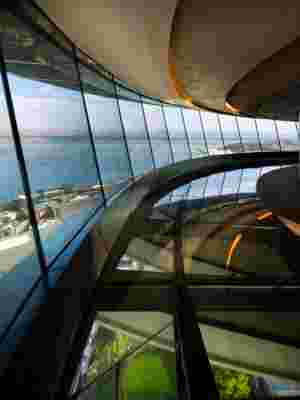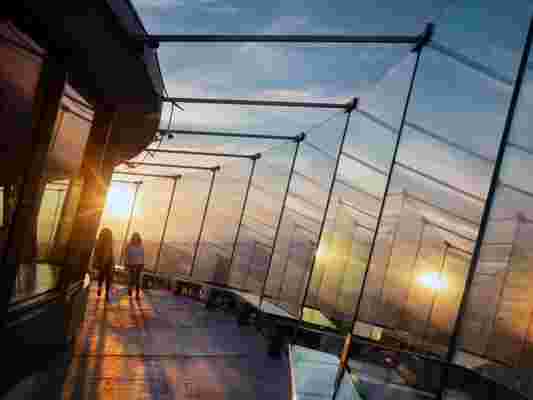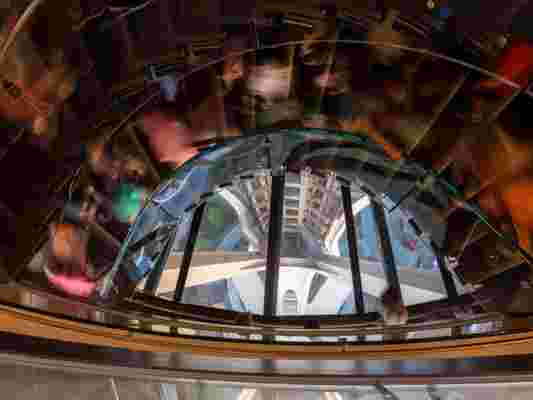During the process to redesign Seattle’s Space Needle , the team conducted a perception study. Upon viewing a photograph of the Seattle skyline, 87 percent of people could identify the city, recalls Alan Maskin, principal at AD100 architecture firm Olson Kundig . When the 605-foot-tall (from base to spire) Space Needle was edited out of the image, only approximately 7 percent could. “Its cultural identity really is intrinsically linked,” he states. So when his firm was eventually hired to renovate the landmark tower’s outdated observation deck, a $100 million project that was recently revealed to the public, maintaining its design intent—and sweeping vistas—was key: “The truth of the matter is that everyone here [in Seattle] thinks that the Space Needle is theirs, and so there is a responsibility to the people that live here to take really good care of the icon of the city,” Maskin says. The results? The world’s first rotating glass floor, a multilevel visitor experience, and more views of the tower (and from the tower) than ever before.

Olson Kundig tore up the flooring of the observation deck and replaced it with glass to reveal the structure below through the world's first rotating glass floor.
Architectural Digest: How did you approach the renovation of this iconic space?
Alan Maskin: There were three major challenges. One was that we needed to revive the visitor experience significantly. We needed to change it. We needed to expand on what it could possibly be. A related challenge is that it is a landmark building and it has a very specific designation. It's a Seattle Landmark, and the designation basically says that you can't change the contour of the building against the sky. We had to balance those two things: How do you change it exponentially from an experience level, but how do you preserve it in terms of the exterior form of the building? And then on top of all that, it’s a construction project that would be 500 feet in the air. We've talked about this a lot. It's almost like building in outer space.
AD: What pieces of the original space did you know you wanted to change and what did you want to preserve?
AM: More than anything else, more than any particular piece of architecture, we wanted to change the experience. We built a 3D model of the existing conditions and because it's on the computer, you can hit the delete button. So based on our research about what the original architects wanted to do, they wanted to provide these pure, unadulterated, expansive views of the city. And that, in our minds, was still the primary goal. What happened over the past 60 years is that many things had been added: walls, strip windows, security cages. So we started to hit the delete button, and we took off the security cages, pony walls, actual walls. We took strip windows and made them floor to ceiling openings. We even peeled up the floor and looked at what it was like if that was taken away as well. And in every instance of removing, we added glass. It became the most significant material we used on the project. Because we could study it in model form, we realized that we were widening the lens in the pupil of the visitor’s eye. In fact, they could see much more than they ever had before. They could see 360-degree views, floor to ceiling glass, glass barriers on the outside. The only thing between them and the view was glass, and then there's the world's first rotating glass floor, which allows you to look 500 feet below you and see parts of the space needle you've never seen before.

Security cages (a later addition) were replaced with glass panels.
AD: Why did you decide that you wanted to tear up the floor and give that view below?
AM: We wanted to reinforce that it was all about the view and that that was everything. Previously you would come up an elevator and the door would open and you'd see a wall that would be to line tourists up so they could come down and then you'd see these strip windows. Again, there were just so many obstructions to the main reason that the building was created in the first place. We spent several years developing these ideas, and ended up having almost 200 percent more glass. Every time we took something away, the view of Seattle became more beautiful and more accessible than it even had been before.
AD: How is the building on display through the glass floor?
AM: We felt that the Space Needle had a very modest view of itself when it was originally designed but 54 years later; we are able to say, this was really innovative architecture and we can actually reveal it. Through the glass floor, you can see the exterior elevators with glass windows that rise and fall out of the building. There’s a kind of choreography to the rhythm of how people kind of come and go. The cantilevered beams that you are literally walking on go through these glass floors. There’s an enormous compression ring, a steel structural ring, and many the structural beams. And they always have been covered. Now, the steel structure has actually become one of the main material pieces in the palette, almost as artifact.

The hourglass profile of the tower, designed by Edward E. Carlson, John Graham Jr., and Victor Steinbrueck, is visible for the first time through the observation deck's glass floor.
AD: Did you change the profile of the structure?
AM: In the 1960s, the original outdoor observation deck had a low wall and people could look over it and the views were quite extraordinary, but over the years, an unsightly security cage was added that surrounded it. We removed it and added these very large, 11-foot-tall glass panels—each weighs over a ton. So between these and the floor, you can lean up to the city and there is nothing, architecturally, getting in the way of you and the view. One of the reasons that we were able to get approval for that is that when we were preparing our meetings with the Landmarks committee in Seattle, we found the original architects. When we studied the original photographs of the architectural model and renderings, we discovered that, in fact, they had wanted to do floor-to-ceiling glass on the inside, but during the construction process in the early '60s, there was a glass shortage in Seattle, so it was probably very hard to get the type they wanted. Ironically, we were able to capture some of the ideas that they had wanted to do but could not.
Two half-moon-shaped glass, steel, and wood staircases connect the observation deck to the Atmos "top-house level" above.
AD: Did you have the idea to replace the security cage with glass before you saw that image of the model?
AM: We did, almost two years before, so it was almost like there was this underlying logic. It confirmed to us that it was the right direction, but I think it also confirmed it to historians in the city, and for the Landmarks board. What’s interesting, and the reason that it was a challenge for Landmarks is that when a building is made a landmark, whatever is designated freezes at the time it is made a landmark. So it wasn’t preserving the 1962 building, it was preserving what the building looked like in 1998. And those security cages and other things that weren’t part of the original idea were protected. We had to help them understand that they could release.
Going back to your very first question, you always wonder how a project will be received, especially one that people really hold in their hearts as the symbol of the place they're from or the place that they are visiting. The reception has been really off the charts positive. There appears to be this universal feeling that the spirit of the place has been maintained, but then, in fact, it has been improved.
RELATED: Seattle’s Iconic Space Needle Prepares to Unveil a $100 Million Renovation
